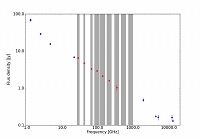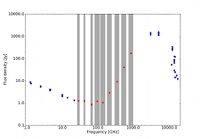Planck's first science results and the release of an extensive compact source catalogue
11 January 2011
The Planck Collaboration presents the first science results to emerge from the mission, covering compact and diffuse foreground emission sources, at a conference held from 10 to 14 January 2011 in Paris, France. These results are accompanied by the release of the first Planck product to be publicly distributed: the Early Release Compact Source Catalogue, a highly robust compilation of compact sources detected in each of the telescope's nine channels. Eagerly awaited by the scientific community, the catalogue contents span a wide variety of astronomical sources, and also includes a sample of galaxy clusters detected through the Sunyaev-Zel'dovich effect and a list of cold molecular cloud cores distributed throughout the Milky Way.Launched on 14 May 2009, ESA's Planck satellite has been surveying the sky in nine frequencies, covering the spectral range 30–857 GHz, since 13 August 2009. The main goal of the mission is to measure tiny fluctuations in the Cosmic Microwave Background (CMB), the relic radiation of the Big Bang; this radiation is, however, "contaminated" by foreground emission arising from cosmic structures of all sizes located between the CMB and us—galaxies, galaxy clusters and, within the Milky Way, gas and dust distributed on small as well as large scales. Thus, a first, necessary step before the rich cosmological information concealed in the CMB can be accessed involves carefully characterising and separating out such foreground emission.
| Animation showing the location on the sky of all compact sources, both galactic and extragalactic, detected during Planck's first all-sky survey and listed in the Early Release Compact Source Catalogue. For larger versions of this video click here. Credit: ESA/Planck Collaboration |
As a by-product, the study of foregrounds delivers an extensive catalogue of individual compact sources as well as a series of maps of the galactic diffuse emission—both of these are valuable resources for a variety of studies in the fields of galactic and extragalactic astrophysics alike. The individual sources detected during Planck's first all-sky survey that are classified as highly reliable are listed in the Early Release Compact Source Catalogue (ERCSC), which is the first scientific product based on Planck data to be made publicly available.
"The mission is now close to completing its third survey of the entire sky and we are extremely satisfied with its performance so far," comments Jan Tauber, Planck Project Scientist at ESA. "This week we are proud to present the first results arising from Planck data, which are based either on the various classes of sources listed in the ERCSC or on the maps of the Milky Way's diffuse emission that have been obtained from the all-sky scans. The ERCSC will be a valuable starting point for follow-up observations to be performed with other telescopes, and it is a privilege to deliver such a robust product to the community in time to exploit fruitful cooperation with other facilities," he adds.
The public release of the ERCSC, which consists of nine lists of foreground sources detected in each of Planck's frequency channels, provides astronomers with an extremely valuable resource. The catalogue has a number of unique features: it has the widest frequency coverage of any catalogue produced by a single telescope scanning the whole sky and it contains the first all-sky inventory of sources at submillimetre wavelengths. Optimised to detect the coldest galactic and extragalactic objects, it is also the first catalogue to cover the complete zoo of extragalactic sources, all the way from radio and infrared-luminous galaxies to clusters of galaxies.
"The ERCSC contains more than 15 000 unique compact sources which have been detected by applying highly reliable algorithms to the data collected by Planck during its first all-sky survey," explains Ranga-Ram Chary from the U.S. Planck Data Center, who led the team that generated this version of the catalogue. "It is a robust database that includes a wide variety of astronomical objects: radio galaxies, blazars, infrared-luminous galaxies, features in the galactic interstellar medium, cold molecular cloud cores, stars with dust shells, galaxy clusters and unidentified objects," he notes.
The ERCSC also incorporates two dedicated resources: the Early Sunyaev-Zel'dovich Cluster Catalogue, a sample of 189 galaxy cluster candidates detected via the characteristic signature they imprint on the CMB through the Sunyaev-Zel'dovich effect, and the Early Cold Cores Catalogue, comprising 915 molecular cloud cores with temperature cooler than 14 Kelvin, the ambient dust temperature in the Galaxy.
"The catalogue has enormous scientific potential, as demonstrated by the breadth of results that have been obtained by the Planck team to date and that are presented this week during the conference," says Tauber. Among the highlights are: the first all-sky survey of galaxy clusters detected via the Sunyaev-Zel'dovich effect and their properties; the first all-sky survey of the densest and coldest parts of the interstellar medium, as well as the coldest distant galaxies; a thorough study of two mysterious components of the interstellar medium in our Galaxy which are made visible by Planck; and the measurement of anisotropies in the Cosmic Infrared Background.
And even more results are expected to emerge in the future: besides representing an excellent resource for scientific investigation by itself, the ERCSC is in fact a rich reservoir of astronomical sources which call for further, complementary observations in several other wavelengths, using either ground- or space-based observatories.
The catalogue is an early product of the mission, comprising the objects in the microwave sky that could be extracted most reliably from the initial Planck maps; the legacy catalogue, to be delivered in 2013, will be deeper and will contain many more objects. "The early release of the ERCSC is intended to offer the community a timely opportunity to follow up many of these objects, taking advantage of fruitful synergies with a series of other observatories which target different wavelength ranges and have a higher resolution with respect to Planck's, but which may have limited lifetime. By doing so, we will optimise our ability to learn as much as possible about the Planck sources," explains Tauber.
Thanks to the early release of the catalogue it will be possible to exploit the synergy with ESA's infrared observatory, Herschel, which was launched together with Planck and has a limited lifetime, set by the nominal operations of its cryostat. Planck and Herschel have a significant overlap in wavelengths, and the possibility of performing observations with these two missions, mapping with Herschel's higher resolution a series of selected targets identified by Planck, is rather unique. Other important follow up opportunities are offered by ESA's X-ray observatory, XMM-Newton, which will complement Planck's observations of galaxy clusters by targeting their hot gas emission, as well as by a number of ground-based facilities, including the Australian Telescope Compact Array (ATCA), the NRAO's Very Large Array (VLA) and the Atacama Large Millimeter/Submillimeter Array (ALMA), and by the airborne-based NASA/DLR Stratospheric Observatory for Infrared Astronomy (SOFIA).
The ERCSC is being released through an online distribution system which can be accessed from the ESA Planck Legacy Archive hosted at ESA's European Space Astronomy Centre (ESAC), as well as the Infrared Science Archive (IRSA) hosted at IPAC/Caltech in Pasadena, California, U.S.A.
Notes for editors
ESA's Planck mission maps the sky in nine frequencies using two state-of-the-art instruments, designed to produce high-sensitivity, multi-frequency measurements of the diffuse sky radiation: the High Frequency Instrument (HFI) includes the frequency bands 100 – 857 GHz, and the Low Frequency Instrument (LFI) includes the frequency bands 30-70 GHz.
The Planck Early Release Compact Source Catalogue (ERCSC) and the first scientific results to emerge from this mission are being presented this week (10-14 January 2011) at the conference "The Millimeter and Submillimeter Sky in the Planck Mission Era" held in Paris, France.
The ERCSC is based on the data gathered during Planck's first all-sky survey, between 13 August 2009 and 6 June 2010. Planck will continue to gather data at least until the end of 2011, during which time it will have completed over four all-sky scans.
The Planck Scientific Collaboration consists of all the scientists who have contributed to the development of the Planck mission, and who participate in the scientific exploitation of the Planck data during the proprietary period, which nominally ends with the release of the scientific products to the community 3.5 yr after launch, i.e. in January 2013. These scientists are members of one or more of four consortia: the LFI Consortium, the HFI Consortium, the DK-Planck Consortium, and ESA's Planck Science Office.
The two Planck DPCs, located in Paris, France and Trieste, Italy, respectively, are responsible for processing and producing the input data for the catalogue; the technical implementation leading to the compilation of the ERCSC has been undertaken by the U.S. Planck Data Center (USPDC) in Pasadena, California, U.S.A. on behalf of the European-led DPCs.
The release of the ERCSC is accompanied by a series of 25 papers that have been submitted today to the journal Astronomy & Astrophysics.
Related publications
Planck Collaboration 2011, "Planck Early Results: The Planck Mission", submitted to Astronomy & Astrophysics
Planck Collaboration 2011, "Planck Early Results: The Early Release Compact Source Catalogue", submitted to Astronomy & Astrophysics
Contacts
Jan Tauber
ESA Planck Project Scientist
Directorate of Science & Robotic Exploration
ESA, The Netherlands
Email: jtauber rssd.esa.int
rssd.esa.int
Phone: +31 71 5655342
François Bouchet
HFI DPC leader
Institut d'Astrophysique de Paris
Paris, France
Email: bouchet iap.fr
iap.fr
Phone: +33 1 44328095
Andrea Zacchei
LFI DPC leader
INAF – Osservatorio Astronomico di Trieste
Trieste, Italy
Email: zacchei oats.inaf.it
oats.inaf.it
Phone: +39 0403199185
Ranga-Ram Chary
U.S. Planck Data Center
Caltech
Pasadena, CA, US
Email: rchary caltech.edu
caltech.edu
Phone: +1 626 395 2693




